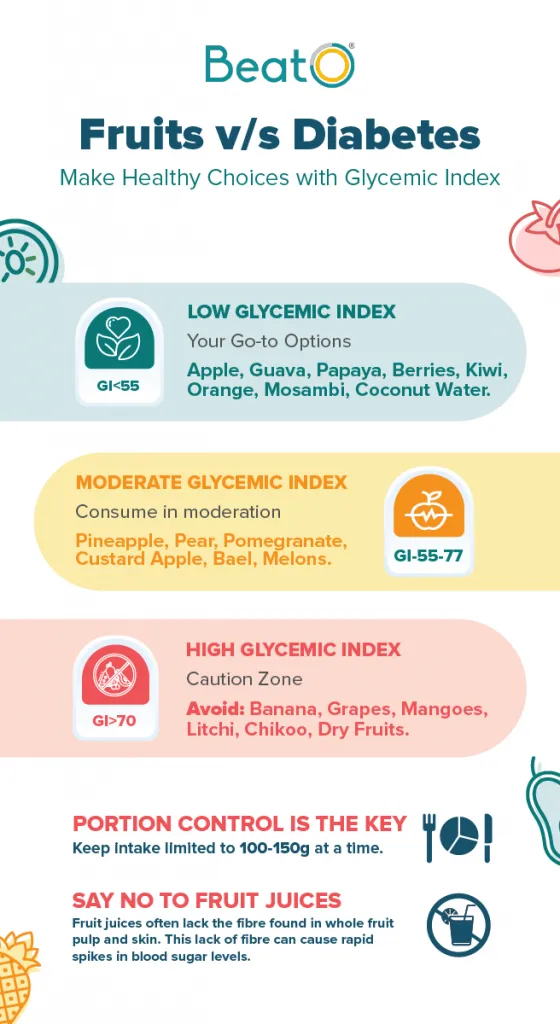If you’re on a quest to manage diabetes like a pro, then you’re in for a treat today. Welcome to the world of BeatO – your expert partner in comprehensive diabetes care. In this article, we will dive into the sweet, juicy, and nutritious world of fruits for people with diabetes, carefully curated by our most credible and experienced Diabetes Health Coaches and Nutrition Experts.

Let’s talk about fruits, shall we?
Picture this – a burst of vitamins, minerals, and fibers, all neatly packaged in colourful, juicy bags that come in different shapes and sizes. That’s right! Fruits are nothing short of nutritional powerhouses. They’re fantastic additions to your diet, and the best part is you can enjoy them in so many delicious ways – in salads, with smoothies, or as on-the-go snacks.
However, when it comes to Diabetic and Pre-Diabetic people, it is important to know that these elixirs of nature have natural sugars too, which can cause a spike in blood sugar levels. So you should know exactly which fruits you should and should not have.
This is where you need to look at the Glycemic Index of fruits.
Let’s understand the term a little better.
Glycemic Index (or G.I.): Your diabetes buddy!
Imagine Glycemic Index as a compass that gives you a direction based on how quickly different foods affect your blood sugar levels. Foods with high G.I. cause your blood sugar to rise quickly, like a rollercoaster, while foods with low G.I. cause a slower and more steady increase, like a gentle slope.
When you eat foods with a high glycemic index, your blood sugar goes up fast and then comes crashing down quickly, making you feel hungry again sooner. But if you choose low glycemic index foods, your blood sugar rises slowly and stays stable for a longer time, which helps you feel fuller and more satisfied for a longer period.

In simple terms, paying attention to the glycemic index can help you choose foods that keep your energy levels steady and avoid the ups and downs that high-sugar foods can bring, even fruits. It’s like picking the right fuel for your body to keep it running smoothly without any hiccups!
Keeping an eye on the glycemic index (G.I.) of the fruits you choose is crucial for managing diabetes effectively.
How to choose fruits based on their Glycemic Index?
- GI < 55
Fruits with a glycemic index below 55 are your diabetic-friendly heroes!
Apple, Guava, Papaya, Berries, Kiwi, Orange, Mosambi, Coconut Water. These wonders are your best buddies and pack a nutritional punch and keep your blood sugar in check.
- GI between 55-70
Fruits like Pineapple, Pear, Pomegranate, Custard Apple, Bael, and Melons with a glycemic index between 55 and 70 can still bring a smile to your face. Enjoy them mindfully, and they’ll reward you with their juicy goodness.
- GI > 70
Now, here’s where you need to tread carefully. Fruits with a glycemic index above 70 can cause glucose spikes, so avoiding Bananas, Grapes, Mangoes, Litchi, Chikoo, and Dry Fruits is best. While they’re undeniably delicious, it’s best to enjoy them sparingly.
Portion control – the sweet secret
An essential factor when it comes to enjoying fruits for people with diabetes is portion control. So, it’s best not to go overboard and keep your intake around 100-150 grams at a time.
Bonus tip:-
Avoid having fruits during your meals or in the form of juices. Your blood sugar levels will thank you for this mindful approach!
So, there you have it, folks – Let BeatO’s comprehensive diabetes care and this sweet fruity guide be your allies in the pursuit of a healthier, happier you. Now, go forth and savour the sweetness of life, one fruity bite at a time! Stay healthy, stay happy!
Disclaimer :
It is crucial to monitor your blood sugar levels using a smartphone-connected glucometer on a regular basis. If you feel doubtful about whether or not you should consume a particular item, you should do a quick sugar check before and after you consume it.
Being a person with diabetes, you can enjoy your favourite treats by making sure that you keep the portion size in check. Overindulging can lead to a spike in your sugar levels. It’s important to discuss with your physician how a food item can affect your blood glucose levels. If you have any doubts about what you can include as a part of your diabetes diet, you should always speak to your doctor or health coach.
Get the best health advice with BeatO!




